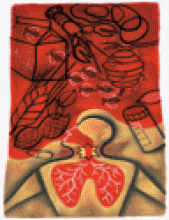Background and epidemiology: Worldwide, waterborne illness accounts for 1 billion cases of diarrhea and an estimated 10–25 million deaths each year, including 95% of deaths among children under the age of 5.1,2 The most common organisms causing such illness are enterotoxigenic species of Escherichia coli, Salmonella, Shigella, Giardia, Cryptosporidium and hepatitis A virus.3,4 Permanent immunity does not usually develop against most pathogens, and reinfection can occur. One or more pathogens are found in the stool of the majority of people from industrialized countries who become ill after travelling to developing countries, which makes “traveller's diarrhea” the most common travel-related illness.5,6
The risk of waterborne illness while travelling depends on the number of organisms consumed, the organism's virulence, the host's defenses and the destination. As few as 10–100 Giardia or Cryptosporidium organisms can cause infection, as compared with 1000 of Shigella, 10 000 of Vibrio cholerae and 100 000 of Salmonella organisms.7 Illness can occur with exposure to, and inadvertent ingestion of, recreational water.8 A few millilitres of water may contain sufficient pathogen to cause illness.
High-risk destinations include Africa, the Middle East, Asia and Latin America,4 where 20%–50% of travellers are affected by waterborne illness. The incidence is high because of the lack of safe water sources and an increased prevalence of diarrheal illness in the local population. In most cases, symptoms in travellers are mild and resolve within 48 hours. Only 10%–20% of patients have severe illness, and less than 1% are admitted to hospital while travelling. Death is unlikely except from infection with specific organisms such as E. coli or V. cholerae, and Cryptosporidium with underlying illness. This is in sharp contrast to the morbidity and mortality from waterborne illness in the local population, which are significantly higher owing to a lack of safe drinking water and food, repeated pathogen exposure, chronic infection and underlying malnutrition.
Clinical management: Fluid and electrolyte replacement is the mainstay for treating traveller's diarrhea. Oral rehydration using the World Health Organization (WHO) solution (Table 1) is effective for patients of all ages, and the solution is commercially available worldwide. Use of loperamide, an antimotility drug, must be limited to 48 hours or less and must be avoided in patients under 3 years old, people with febrile symptoms and people with blood in their stool. Empiric antimicrobial therapy is indicated if travellers have 3 or more loose stools in 8 hours, because of the high risk of a bacterial cause. The oral antibiotic of choice in adults is ciprofloxacin (500 mg twice daily), and in children it is trimethoprim–sulfamethoxazole (3 and 15 mg/kg respectively twice daily).4 Travellers should seek medical attention and stop antibiotic therapy if diarrhea persists or worsens.
Table 1.
Prevention: Travellers cannot reliably determine the safety of water on the basis of its look, smell or taste. Tap water in most tropical or underdeveloped countries is contaminated. Springs and wells may be contaminated, and locally bottled water may be unsafe owing to unsanitary bottling practices or contamination of the water source itself. Hot tap water and ice cubes are unsafe. Water can be made safe for drinking with the use of heat, chemical treatment or filtration.
Boiling water inactivates all common waterborne pathogens.
Halogens (chlorine and iodine) work by oxidizing essential cellular structures and enzymes. Non-spore-forming bacteria are very susceptible to halogens, viruses have intermediate susceptibility, but protozoan cysts and spores are resistant. Chlorine dioxide is a safe halogen preparation and is effective against all waterborne pathogens. A stable form of chlorine dioxide is available as a single-step method to disinfect drinking water. Halogens have an objectionable taste and smell that is minimized with the use of flavoured drink crystals or filtration of the water after halogenation. The possible toxicity from long-term iodine use is controversial; the WHO recommends that iodine be used as an emergency measure for no more than 3 weeks.9
Filters adsorb pathogens to compressed activated carbon or prevent their passage through ceramic material. Activated carbon filters adsorb organic (vegetation) and inorganic (urea, pesticides, heavy metals) matter and trap, but do not kill, microorganisms. However, these filters do not disinfect water and can become colonized with microorganisms.
The optimal method to ensure safe drinking water depends on the quantity of water required, the quality of the water source and the fuel availability. In developing countries where there is human or animal activity, surface water is highly contaminated and requires disinfection with heat, chlorine dioxide, or a 2-step process (filtration plus halogenation). Charcoal filtration before disinfection removes organic and inorganic matter. Halogens should be added to stored water to prevent pathogen growth. Table 2 lists the advantages and disadvantages of each method.
Table 2.
In addition to water disinfection, travellers must use safe food preparation methods and practise good personal hygiene to prevent enteric illness. Food should be washed with disinfected water, boiled or peeled. Proper handwashing prevents contamination of food during meal preparation. Dishes and utensils should be disinfected with bleach. Human waste should be buried 20–30 cm deep, at least 30 m from any water, at a location where water runoff will not contaminate nearby water sources.
Prophylactic antimicrobial agents are not generally recommended owing to potential alternation of normal bacterial flora, development of resistance, side effects and a false sense of security.4,6 Travellers may opt for vaccination to protect against illness. In addition to an effective hepatitis A vaccine, there are now vaccines effective against cholera and E. coli.
Valerie F. Krym Department of Community Health Sciences University of Manitoba Winnipeg, Man. Russell D. MacDonald Division of Emergency Medicine Department of Medicine University of Toronto Toronto, Ont.
Footnotes
-
This is an abridged version; the full version is at www.cmaj.ca.











